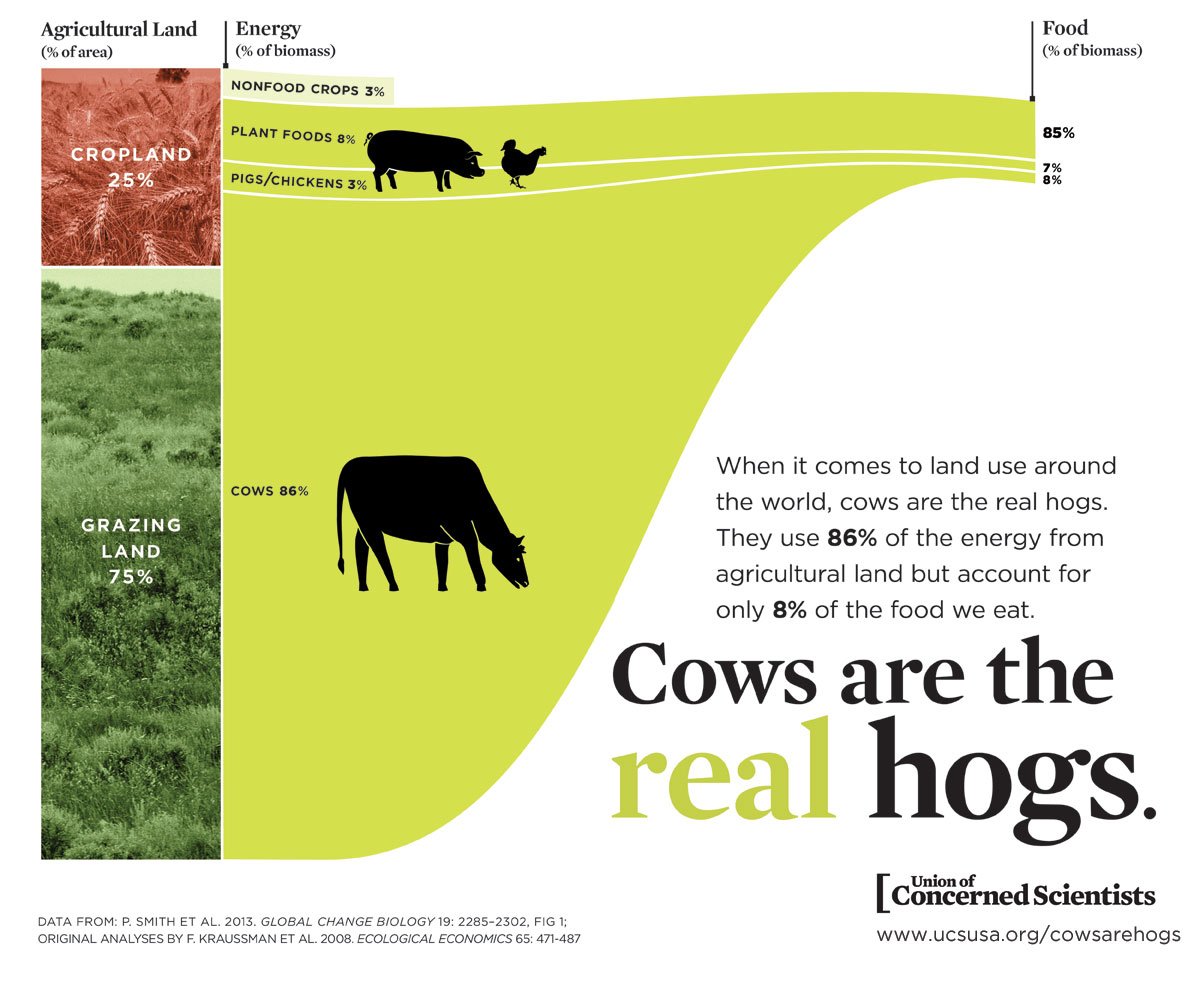One small but important breakthrough in the new IPCC report on climate mitigation, released Sunday in Berlin, is that the chapter on agriculture, forest, and other land use (AFOLU) looks at the demand side, not just supply. In other words, it not only asks how we can create less global warming pollution in producing food and wood products, but also what kinds of food and wood products we ought to be producing and consuming if we want to avoid catastrophic climate change.
Unlike previous reports, it doesn’t assume that consumption patterns are fixed and can’t change, or that they should just be left to be determined by “the market.” Rather, it examines what options could reduce waste in the food system and provide healthy diets for all, while cutting the 25 percent of greenhouse gas emissions that come from the AFOLU sector.
And when we started to examine these demand-side approaches, the first thing to look at is cows. Because when it comes to land use and climate, they’re the ones that are the real hogs.
This statement is the short summary of a new infographic from UCS, based on results from an important review paper by Pete Smith et al. published last year in Global Change Biology, which in turn used data from the global analysis of energy flows from land to food done by Fridolin Krausmann and colleagues.
The upshot of these studies is that cows use enormous amounts of biomass as well as the large majority of the planet’s agricultural land, yet produce a very small amount of our food.
Here’s the information that the infographic is based on. About 60 million square kilometers of land around the world is used for agriculture. A quarter of that is cropland while three-quarters of it is used for grazing. The Smith et al. and Kraussman et al. papers show that the vast majority of the energy from agricultural land is used for cattle (and other ruminants), while only a small portion is used to produce plant-based food for direct human consumption or feed for pigs and chickens (what scientists call “monogastrics” — or literally animals with one stomach).
The crops and pasture grasses produced on agricultural land can be measured as the energy, originally from the sun, that is in the biomass that we or our animals grow or eat. For example, crops and pasture are used to produce cattle, but crops like corn are also grown to feed people directly. All of the energy involved in these processes can be expressed in billions of tons of biomass.
As the graphic shows, most of the land and most of the biomass is used to feed cows. But when we look at the proportion of human food that is produced from all this energy, we see how inefficient this part of the human diet is. Cows, despite taking in 86 percent of the biomass, produce very little food (only 8 percent of the total). In contrast, both plant-based foods and chickens and pigs are much more efficient converters of biomass into things we can eat.
This inefficiency is important to global warming pollution, because much of the land that is used for pasture came from cutting down forests, which emits CO2. Furthermore, production of crops and other livestock feed leads to the emissions of powerful greenhouse gases, such as the nitrous oxide (N2O) that results from fertilizer use.
But there’s another element that’s specific to cows and other ruminants, and makes them different from chickens and pigs. That’s the methane (CH4) that ruminants produce, both directly and in their manure. These emissions – which are essentially zero for monogastrics – are the largest single source of agricultural emissions. So in addition to the climate damage due to the land and the biomass that cows consume, they also produce large quantities of the greenhouse gas that is 25 times as strong as CO2.
The reason this is important, and why the IPCC has begun to focus on the demand side of agriculture, is that the emissions related to cows can be reduced greatly by switching consumption to other kinds of meat such as pork and poultry. In fact, diets have been changing rapidly all over the planet, and how they change in coming decades – e.g. towards more beef, or more chicken – will make a very big difference to our future greenhouse gas emissions.
Of course, cows have important values besides the food they provide. In traditional pastoral societies they are often the main store of wealth and a reserve that can be called on in hard times. For many farmers in developing countries cattle are the chief source of draft power, to plow their fields and transport their crops to market. So it’s important to distinguish among countries at different economic levels, and among continents in which the role of livestock and of feed grains differ greatly. In the U.S., for example, the vast majority of our corn goes to feed livestock and to produce ethanol, while in Latin America and sub-Saharan Africa it’s the most important cereal grain consumed directly by people.
Nonetheless, on a global scale the climate impacts and land needs of cattle are far higher than those of alternative foods. This is why we’ve been suggesting policies to promote diet shifts away from beef and towards lower-emissions foods such as pork, poultry, eggs and of course plants. These kinds of changes in demand in developed countries like the U.S. – not just how we produce the food we eat, but what kind of food we choose to eat – would improve our health, reduce the wastefulness of our use of land and energy, and produce more food at the same time. As well as helping to save our climate – all in all, a whole lot of benefit for people and for the planet.

